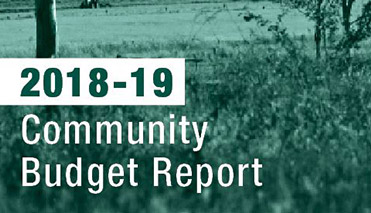Budget Focuses on Region's Sustainable Future

The continued renewal and restoration of the region's road and bridge network is a key focus of Scenic Rim Regional Council's $112 million Budget for 2018-19.
Mayor Greg Christensen said Council's Budget included $26 million for capital improvements to roads, bridges, footpaths and drainage across the Scenic Rim to meet the growing needs of a growing region.
"Structured under our Corporate Plan, Scenic Rim 2023, this year's Budget reflects Council's mission to enable a sustainable future for our region that enhances our unique rural communities and environments," he said.
In 2018-19, Council is planning to complete $25 million of flood restoration, as well as Betterment works to improve the resilience of local infrastructure to damage from future flooding. The total flood restoration and Betterment works being delivered across the 2017-18 and 2018-19 financial years will account for more than $55 million when completed.
"Our financial settings for the year ahead are geared to sustainable economic development and growth which relies heavily on infrastructure and services.
"Roads and bridges not only connect the communities of our region but are key drivers of our regional economy and our investment in infrastructure aligns with the vision we share with the community for the Scenic Rim as a sustainable and prosperous economy."
Ongoing works to repair $38 million in damage to roads and bridges from ex-Tropical Cyclone Debbie in 2017 are to be completed by the end of the 2018-19 year, with 75 per cent of the funding from the Natural Disaster Relief and Recovery Arrangements from the Australian Government and 25 per cent from the Queensland Government.
Council continues to supplement more than $8 million of Betterment funding from the Australian and Queensland Governments to ensure key roads and bridges will be more resilient to damage from future flooding during extreme weather events.
"Through sound asset management practices, we are ensuring the best value to ratepayers for our investment in infrastructure that provides the impetus to the ongoing growth and economic development of our region," Cr Christensen said.
Total capital and operational expenditure for Council in 2018-19 includes:
Roads and Bridges $34.22 million
Disaster Restoration $15 million
Vibrant and Active Towns and Villages $1.30 million
Community buildings and facilities $7.38 million
Parks and Gardens $3.22 million
Community and Cultural programs $5.82 million
Waste Operations $8.60 million
Planning $2.87 million
Health, Building and Environment $5.22 million
Cr Christensen said the Budget balanced community needs and the Queensland Government's legislative criteria which requires councils to generate revenue through rates linked to property valuations.
Individual rating outcomes will vary in 2018-19 following the State Government's land valuations of 2018, the first in three years.
"With valuation increases of up to 80 per cent in some areas, we recognise the valid concerns of residents in relation to the potential impact of significant increases in parts of our region," Cr Christensen said.
"These were taken into account in developing this year's ratings outcomes.
"After considering a range of options, we have adopted a model of three-year land valuation averaging, coupled with rate capping, to lessen the effect on rates outcomes resulting from the valuations volatility.
"This means a 2.1 per cent increase in the minimum rate for residential and rural principal places of residence. A capped nine per cent increase has been applied for rates on rural and residential properties that are a principal place of residence."
Seventy-five per cent of principal place of residence ratepayers will have an increase of less than 2.5 per cent, while half of those will experience no rate increase.
"In simple terms, for an owner-occupied residence on the minimum general rate of $1,203, an increase of 2.1 per cent represents a difference of $25 a year or 48 cents per week," Cr Christensen said.
